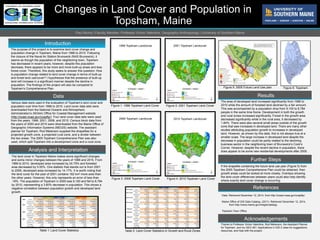
Land Cover and Population Changes in Topsham, ME from 1996-2010
- 1. Changes in Land Cover and Population in Topsham, Maine Paul Morris | Faculty Member: Professor Vinton Valentine, Geography-Anthropology | University of Southern Maine Introduction The purpose of this project is to examine land cover change and population change in Topsham, Maine from 1996 to 2010. Following the closure of the Naval Air Station Brunswick (NAS Brunswick), it seems as though the population of the neighboring town, Topsham has decreased in recent years; however, despite this population decrease, there appears to be more and more built-up areas and less forest cover. Therefore, this study seeks to answer this question: How is population change related to land cover change in terms of built-up and forest land use/cover? I hypothesize that the presence of built-up land will increase in a significant manner despite the decline in population. The findings of the project will also be compared to Topsham’s Comprehensive Plan. Data Analysis and Interpretation Results References Acknowledgements Various data were used in the evaluation of Topsham’s land cover and population over time from 1996 to 2010. Land cover data sets were downloaded from the National Oceanic and Atmospheric Administration’s (NOAA) Office for Coastal Management website (http://coast.noaa.gov/ccapftp/). Four land cover data sets were used from the years, 1996, 2001, 2006, and 2010. Census block data from the years of 2000 and 2010 were downloaded from the Maine Office of Geographic Information Systems (MEGIS) website. The assistant planner for Topsham, Rod Melanson supplied the shapefiles for a projected growth zone, a projected rural zone, and a divider between the two areas. The 2005 Topsham Comprehensive Plan was also used, which split Topsham into a development zone and a rural zone. Data. Retrieved December 12, 2014, from http://coast.noaa.gov/ccapftp/. Maine Office of GIS Data Catalog. (2011). Retrieved December 12, 2014, from http://www.maine.gov/megis/catalog/. Topsham Town Office. If the shapefile containing the future land use plan (Figure 5) from the 2005 Topsham Comprehensive Plan could be obtained, then growth areas could be looked at more closely. Overlays showing the land cover differences between years could also help identify where exactly land cover change is occurring. The area of developed land increased significantly from 1996 to 2010 while the amount of forested land declined by a fair amount. This was accompanied by a population drop from 9,100 to 8,784 people in the same time frame. Development in both the growth and rural zones increased significantly. Forest in the growth area decreased significantly while in the rural area, it decreased by 1.84%. There were also several small areas outside of the growth zone that saw increases in developed land. There are many other studies attributing population growth to increases in developed land. However, as shown by this data, this is not always true at a smaller scale. The large increase in developed land despite the decrease in population could be partly related to the declining business sector in the neighboring town of Brunswick’s Cook’s Corner. However, despite the recent decline in population, there does appear to be some new residential developments after 2005. Thanks to Professor Vinton Valentine, Rod Melanson, the Assistant Planner for Topsham, and my GEO 481: Applications in GIS 2 class for suggestions, resources, and help with the project. The land cover in Topsham Maine makes some significant changes and some minor changes between the years of 1996 and 2010. From 1996 to 2010, developed area increased by 24.75% and forested area decreased by 5.05%. One statistic that stands out is from 2001 to 2006, developed area increased by 14.17%. It is worth noting that the land cover for the year of 2001 contains 162 km2 more area than the other years. However, this only represents an error of less than .18%. The population of Topsham in 2000 was 9,100 and fell to 8,784 by 2010, representing a 3.60% decrease in population. This shows a negative correlation between population growth and developed land growth. 10/9/2005 Figure 1: 1996 Topsham Land Cover Figure 2: 2001 Topsham Land Cover Figure 3: 2006 Topsham Land Cover Figure 4: 2010 Topsham Land Cover Figure 5: 2005 Future Land Use plan Table 1: Land Cover Statistics Table 2: Land Cover Statistics in Growth and Rural Zones Further Steps Figure 6: Topsham
